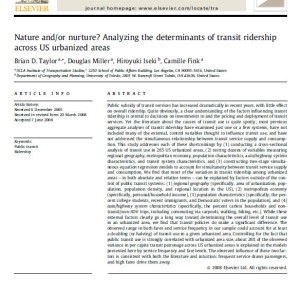
Authors: Brian D. Taylor, Douglas Miller, Hiroyuki Iseki, Camille Fink
Date: January 1, 2009
Project: [wpv-post-link id=”$project”]
Public subsidy of transit services has increased dramatically in recent years, with little effect on overall ridership. Quite obviously, a clear understanding of the factors influencing transit ridership is central to decisions on investments in and the pricing and deployment of transit services. Yet the literature about the causes of transit use is quite spotty; most previous aggregate analyses of transit ridership have examined just one or a few systems, have not included many of the external, control variables thought to influence transit use, and have not addressed the simultaneous relationship between transit service supply and consumption.
This study addresses each of these shortcomings by (1) conducting a cross-sectional analysis of transit use in 265 US urbanized areas, (2) testing dozens of variables measuring regional geography, metropolitan economy, population characteristics, auto/highway system characteristics, and transit system characteristics, and (3) constructing two-stage simultaneous equation regression models to account for simultaneity between transit service supply and consumption. We find that most of the variation in transit ridership among urbanized areas – in both absolute and relative terms – can be explained by factors outside of the control of public transit systems: (1) regional geography (specifically, area of urbanization, population, population density, and regional location in the US), (2) metropolitan economy (specifically, personal/household income), (3) population characteristics (specifically, the percent college students, recent immigrants, and Democratic voters in the population), and (4) auto/highway system characteristics (specifically, the percent carless households and non-transit/non-SOV trips, including commuting via carpools, walking, biking, etc.). While these external factors clearly go a long way toward determining the overall level of transit use in an urbanized area, we find that transit policies do make a significant difference. The observed range in both fares and service frequency in our sample could account for at least a doubling (or halving) of transit use in a given urbanized area.
Link to Publication